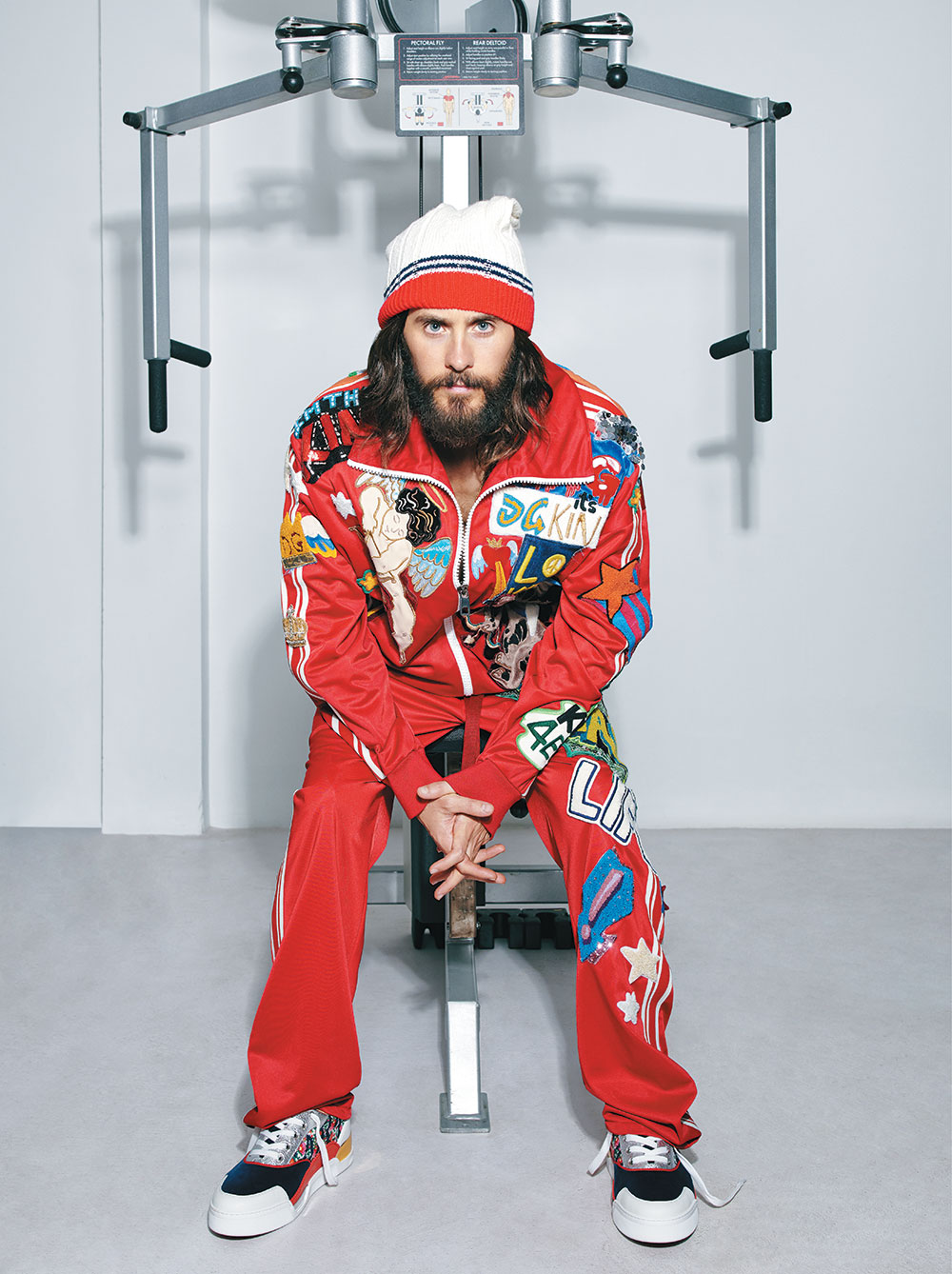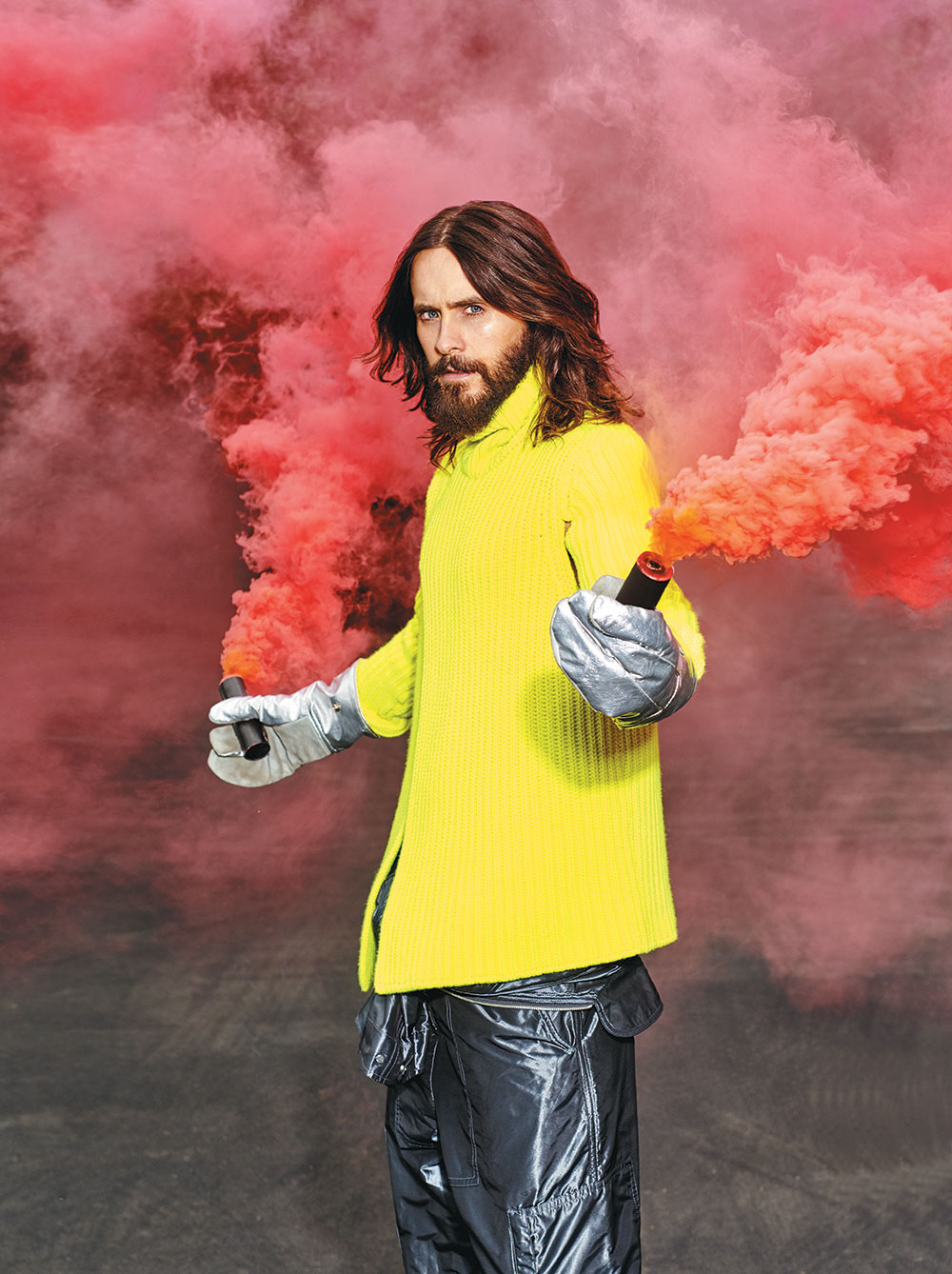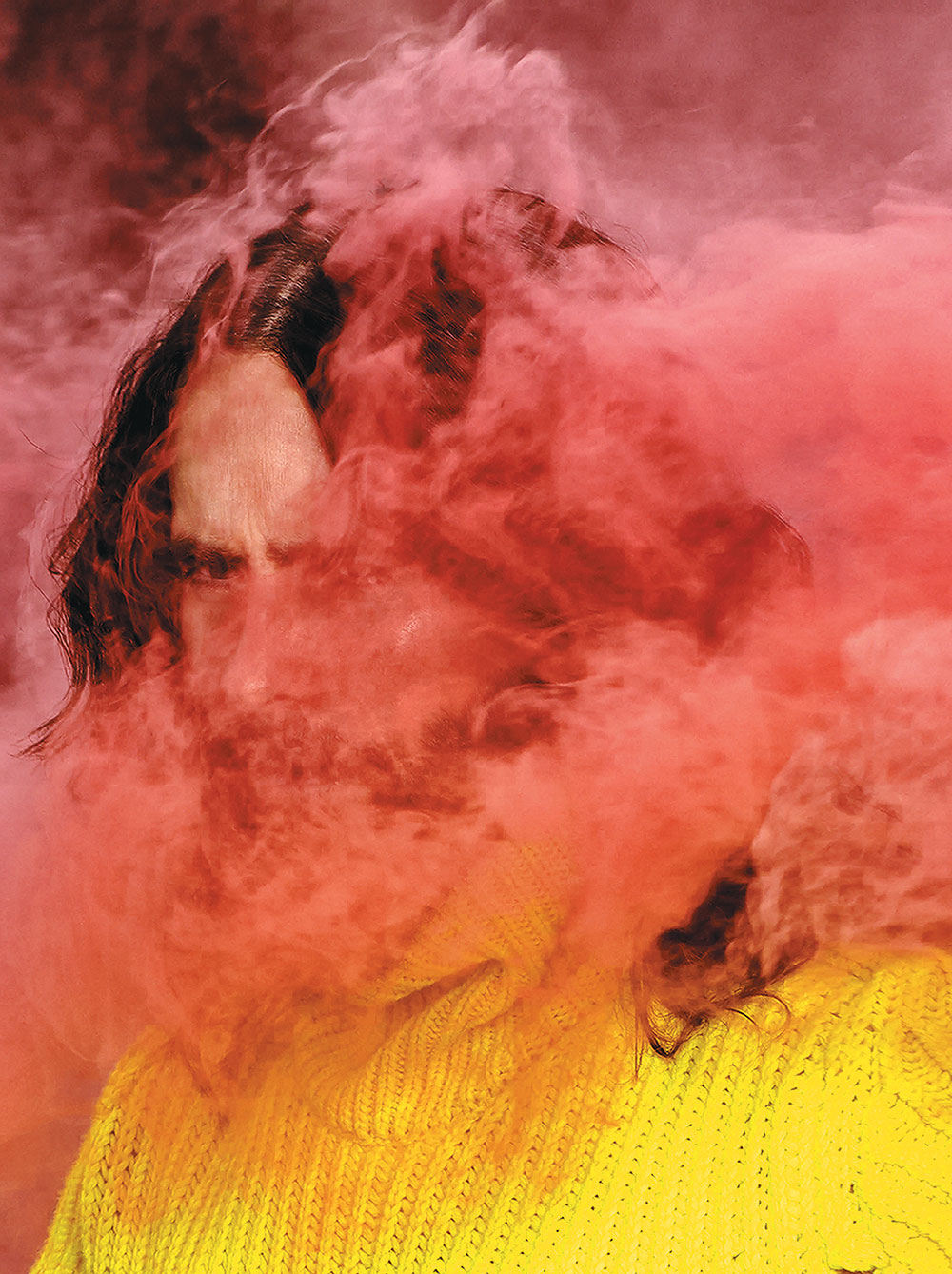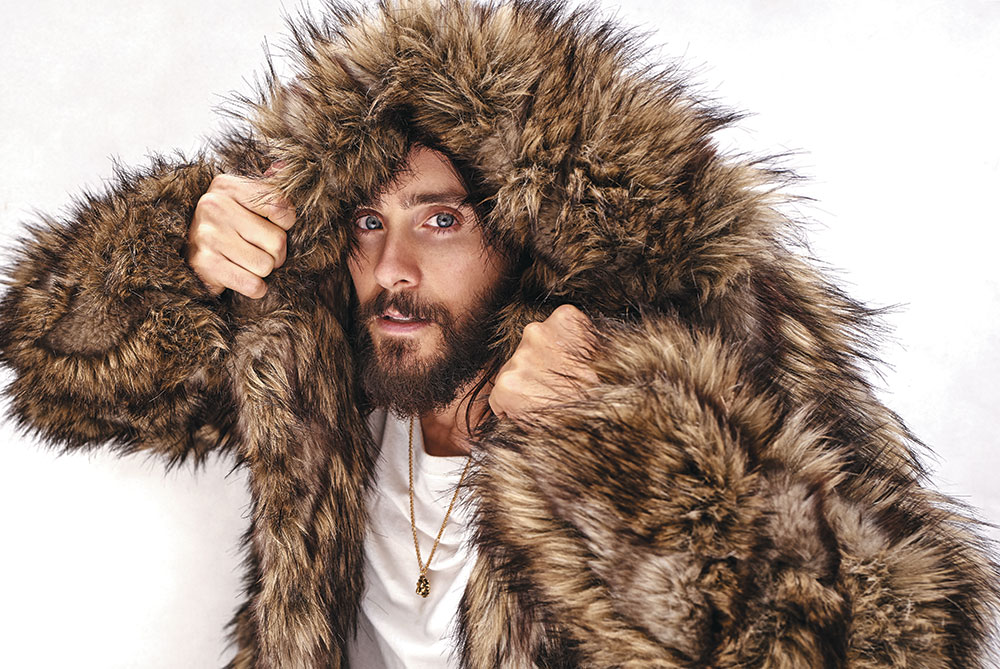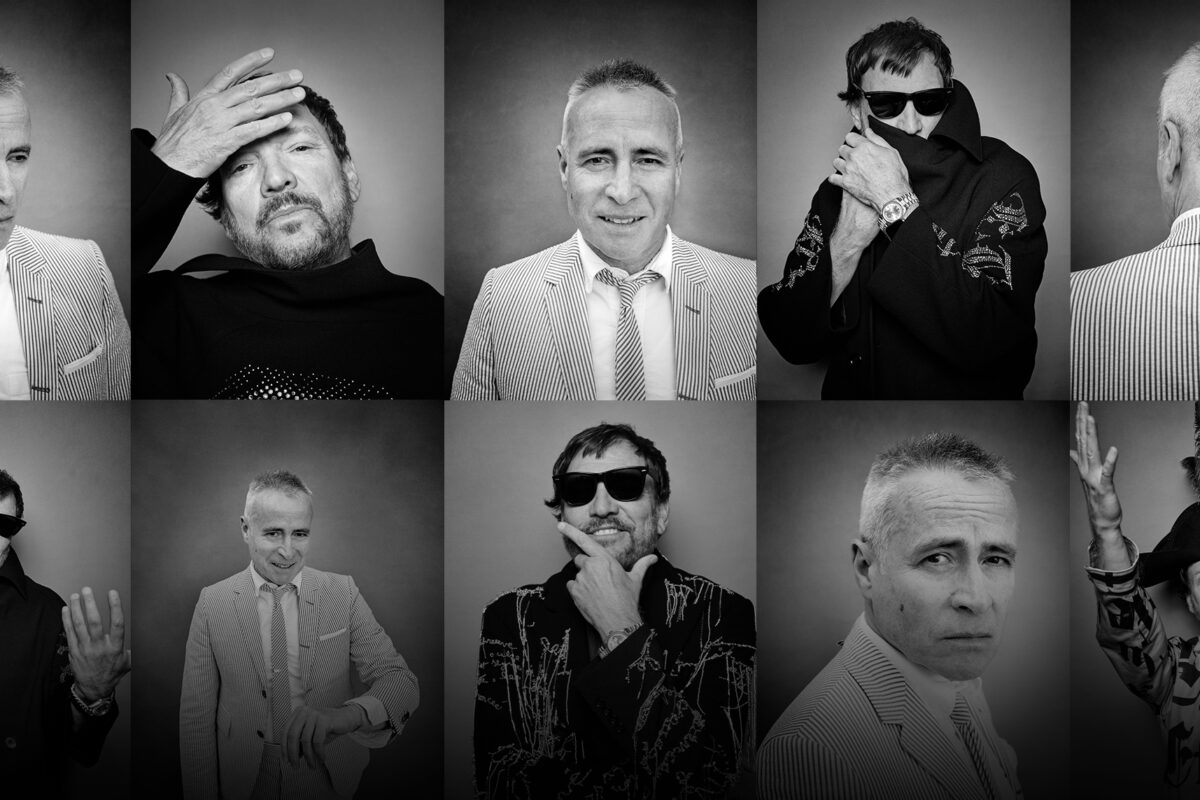Jared Leto tells Stephanie Rafanelli why taking risks—whether he’s performing in front of 20,000 people or hanging off a cliff in Yosemite—is his raison d’être
Words by STEPHANIE RAFANELLI
Photography by GAVIN BOND
Creative and fashion direction by ALISON EDMOND
If Laurel Canyon’s Lookout Mountain could talk, it might betray all sorts of secrets: tales of LSD-popping and bed-swapping, Satanic cult meetings, the truth behind conspiracy theories and even military intelligence. It is a neighborhood rife with X’s on the maps of curiosity hunters. And, in a clandestine location behind metal gates, lies one such example: a former classified Air Force compound built during World War II that later became a rehab clinic. Inside one of its sparsely furnished, hospital-like rooms, the property’s owner sits on a sofa—a Jesus-meets-Ken doll in a pink skater-style T-shirt, fuchsia patterned sweatpants and stripy socks. The bearer of all this Gucci is the enigma that is Jared Leto.
The bareness of the surroundings may seem counter to his sartorial maximalism, but, he says calmly, “I’ve always loved minimal.” He adds, “I have 50 rooms here and I guarantee that 46 of them are empty.” In fact, six months ago it took him at least half a day to discover he had an uninvited roommate who had jumped the compound’s fence. “My assistant showed up and said, ‘Do you have a guest in the guest bedroom? Because there’s someone sleeping in there.’”
Last night, at The Forum, on the Los Angeles leg of his band Thirty Seconds to Mars’ “Monolith Tour” promoting their fifth studio album, America, Leto whooped and sprinted in circles onstage in a gold sequined ’70s-style suit and a technicolor dream coat, leading his fans in a mass sing-along. Today, he is as placid and composed as a spiritual guru, with a biblical beard, a man bun and alarmingly clear-blue eyes. You might think Alessandro Michele designed the blue suit of Leto’s Baroque Christ look at this year’s Met Gala to match the aforementioned gaze—in recent years, Leto has become the Gucci designer’s friend and muse, a veritable ’70s rock dandy peacock. He insists his outfit today is “a happy accident” and that his gray clogs are “probably from Kmart.” “As far as my fashion choices go,” Leto adds, “I don’t give a f—!”
The haute fashion muse, 46-year-old dedicated rock star and award-winning video and documentary director is also, of course, a part-time method actor known for extreme acts of self-remolding. Most of his co-stars have never “met” him because he never breaks character on set. In addition to all of that, he’s a futurist, a shrewd tech investor, an early believer in the immersive digital age. He’s also a canny marketer—in 2013, he sent his band’s single “Up in the Air” aboard SpaceX’s Dragon capsule to the International Space Station. Currently he’s editing a documentary, A Day in the Life of America, out of footage filmed on a single day by 92 crews in all 50 states, plus Washington, D.C., and Puerto Rico, and home footage from 10,000 invited fan submissions. So many busy Jared Letos, all coexisting in one prolific man.
He seems to enjoy the shroud of mystery surrounding him. Not one to explain himself or lose control in an interview, he is polite and obliging, alternately earnest and high-minded—“We’re just a speck of dust floating in the small distant corner of the universe”—and occasionally drawn into playful provocation. When I joke that he has discovered the secret to immortality and that surely his baby-skin complexion cannot be the product of veganism alone, he grins and shoots back, “I do have a secret. I told Alessandro [Michele].” Referring to the red liquid he was drinking on stage last night, he says, “Maybe it was blood.”
The album artwork for America, which entered the Billboard charts at No. 2 when it was released in April, is equally provocative. Credited to Leto, who worked in collaboration with art director Willo Perron, it comes in 10 different versions, each emblazoned with typography representing snapshots of American contemporary culture—listing the most profitable prescription drugs, for example, or the most highly paid YouTubers. Another lists sexual positions: Cowgirl, Doggy, Face, 69, Scissors, the Crab. “You have an entire generation of people [who] are growing up with access to pornography. That’s going to change things, because we are all very visual animals, right? We learn so much from what we see and how we see other people behaving,” he explains. “I think because we now have these fleeting relationships via our social graphs, in 10 or 20 years it will be less common for people to be in relationships, as we think of intimate relationships today.”
*****
I last met Leto in Helsinki at a Thirty Seconds to Mars gig a few days after he won the award for best supporting actor at the 2014 Academy Awards for playing Rayon, the transgender drug addict with AIDS in Dallas Buyers Club (2013), his first film since the 2009 drama Mr. Nobody. While most actors would have capitalized on this win—chasing more Oscars and maybe settling down in a nice house in Bel-Air—Leto went on touring with his bandmate, his older brother, Shannon, and didn’t make another feature film for three years. In 2011, Thirty Seconds to Mars set a Guinness World Record for most live shows during a single album cycle, with 309 concerts during its “Into the Wild” tour, about which Leto made a documentary that premiered in 2014.
I ask him now, what does he get from playing all those concerts? “There are chemicals released [in the brain] when people sing together that are very similar to the chemicals that are released when people are in love. And it creates a feeling of well-being, bonding, euphoria,” Leto explains. Does he feel like he’s in love, too? “Absolutely. Not every night. But the beautiful thing about making music is that you always get another chance.” He says touring is now more or less a way of life. This is his first day at home in three months, and he confesses that he wasn’t ready to come back. Does he get restless here? “When I’m back, I end up not leaving the house, so it gets pretty isolating.”
After his big break as the beautiful stoner Jordan Catalano in the 1994 ABC teen drama My So-Called Life, he eschewed all pretty-boy leads. Like Angel Face, his character in Fight Club (1999), who is liberated from his handsomeness when his face is beaten to a pulp, Leto took on only self-punishing roles, characters who were in some way physically or spiritually disfigured. He reportedly lived on the streets of New York with junkies to play the heroin addict in Requiem for a Dream in 2000. He speed-gained 67 pounds to play John Lennon’s assassin, Mark David Chapman, in Chapter 27 (2007), giving himself gout and confining himself to a wheelchair. And six years later, to play Rayon, he dropped about 40 pounds so quickly that it endangered his health. “I have very strong self-control. There is something very seductive about it,” he said to me back then in Helsinki.
Leto appears to be drawn to the flame of danger—as if needing to test his own limits again and again. “I think that you feel most alive when you’re on the edge,” he says. When he returned to the silver screen in 2016, it was as the Joker in DC Universe’s supervillain blockbuster Suicide Squad. “I always found the Joker really intoxicating because you are living in the skin of someone who has no rules,” he tells me. “It taught me to be braver as an actor. I felt like I was doing my bravest work. Taking a beloved character and putting a new spin on it is already a Sisyphean task. It was just very risky, because of the trepidatious waters of the history of that part.” (Actor Heath Ledger died shortly after completing his own fearsome turn in that role, posthumously winning an Oscar for 2008’s The Dark Knight.) With the upcoming Suicide Squad 2, as well as two slated spin-offs including a solo Joker film, Leto will return to that unhinged place and risk it all again.
It is perhaps no surprise that he is an avid rock climber, often posting photos of himself on Instagram halfway up a mountain face in Yosemite or one of his favorite spots, Joshua Tree. “I know that there’s a risk involved in some of the things that I do and that I’ve done in my life, but I don’t take a blind jump ever,” he says. “I rock climb safely. And yes, there are times where I’ll take off the rope and, yes, there is a possibility that I could slip, fall and die. I’m not afraid to take risks: [physical] risk, creative risk, business risk. But it’s calculated risk.” Does he get a thrill from fear? “There’s the fear when you’re on a roller coaster and you’re like, ‘This is so scary, this is great.’ And then there’s that other kind of fear, when you’re so anxiety-ridden you want to puke: When it’s emotional, it’s worse than when it’s physical.” He yawns—he does this when the topic veers close to personal territory. “For me, if someone were to break your heart or betray you or you failed so greatly that you felt that you let people down—that to me is much worse.”
*****
Leto’s personal life has always hung enigmatically in the air. Decades of prolific dating rumors have rarely been confirmed or denied (his exes include Cameron Diaz and Scarlett Johansson). And he has painted his upbringing in broad, romantic brushstrokes with gaping holes: “I don’t think about the past much,” he says, “I believe in the future.”
As the story goes: Leto was born in Bossier City, La., to a young mother, Constance, who had two sons by age 20. His father left after he was born, and Leto never saw him again. He subsequently committed suicide when Leto was 8. Leto, his brother Shannon, and their mother soon fled Louisiana and adopted a hippie lifestyle, traveling around America from Colorado to Virginia, Wyoming, Alaska and as far away as Haiti, bunking in communes with actors, artists and musicians. They would return to Louisiana to visit their Cajun grandparents, spending summers in their one-bedroom house. The Leto brothers became wild and tough as they grew up, breaking into warehouses, dabbling with drugs. “Some kids went and did summer camp; we went and stole your car,” he once told The Sunday Times. In 10th grade, he dropped out of school for a while, before steering himself out of a nosedive and returning to Emerson Preparatory School in Washington, D.C., finding his salvation in art. It was while at The University of Arts in Philadelphia that he fell in love with directing, and he subsequently moved to New York to study film at the School of Visual Arts.
When he moved to Los Angeles in 1992, at age 19, it was to pursue a career as a director, supported by part-time acting. Today L.A. is not only the movie capital of America, but a hub for space and tech innovation—both fields that Leto is invested in either emotionally or financially. He has been an investor in more than 60 companies, at last count, including Uber, Spotify, Airbnb, Slack, Robin Hood and Headspace. In 2011, he launched VyRT, an online platform for live-streaming events, and he founded The Hive, a digital marketing and social media agency. Like Elon Musk, who partially inspired Leto’s God-like character Niander Wallace in 2017’s Blade Runner 2049, Leto has few qualms about the automated future. “Maybe we need [artificial intelligence] to tell us how to make decisions, because we’re not making very good decisions on our own, are we?”
His band came up with the name Thirty Seconds to Mars 20 years ago, in 1998, when travel to the red planet was still science fiction, rather than a future reality. “We’re going to have to become an interplanetary species in order to survive, if we hope to have future generations, because we can’t satiate our appetites enough to stop us [from] destroying the most important asset that we have, which is the planet,” Leto says. “We’re absolutely running toward the edge of the cliff here. I think it’s inevitable.”
Notwithstanding these future projections, in the near term, Leto has had to step back a little from technology, namely his smartphone. “I’ve actually learned to become less reliant on my phone, namely because it’s been contributing to body pain,” he explains. “It’s probably the stress and pressure and the phone being the source of my workload. My body was screaming out for some peace.” Surely the discomfort is negligible compared to what he has actively self-inflicted for his roles, but there are even signs that his taste for that is waning. He says he is looking forward to making more “crowd-pleaser” films; next up, he’ll play the antihero vampire Dr. Michael Morbius in Sony Pictures’ upcoming Marvel-based spinoff Morbius. It doesn’t sound that light.
“I think it sounds like a lot of potential fun,” he says. But he doesn’t do fun. “True, I don’t do fun!” he admits with a laugh. “But I think I deserve it now at this point. God knows I’ve depressed enough audiences. I don’t mind making a film that has the potential to make audiences really happy. And sometimes it’s just great to go to the movies, get some popcorn, [and] watch something ridiculous and over the top.”
Is it time for his reinvention as a rom-com lead? “I would [do one] in a heartbeat,” he says. “I’d like to do the opposite of a ‘McConaughey.’ Remake all of his romantic comedies. Or just do rom-coms on the beach in Hawaii…Elvis Presley movies, man! Because as you get older, why would you want to suffer more? All my old agents are probably rolling over saying, ‘Why couldn’t he have done this 20 years ago?’” But he is most excited about playing a personal hero of his in an upcoming biopic being written by The Wolf of Wall Street’s Terence Winter: “Andy Warhol has always been an inspiration to me. I think his greatest work of art was himself. If I was braver, I love the idea of making yourself your greatest work of art. He became who he dreamed of being,” he says. Then, as if describing himself, he adds: “He was a self-made, self-created enigma.”
Hair by DAVID COX at Art Department using Kevin Murphy.
Grooming by JAMIE TAYLOR at the Wall Group.
Fashion assistant: MOLLY DOWNING.
This story originally appeared in the Fall 2018 Men’s Edition of C Magazine.

